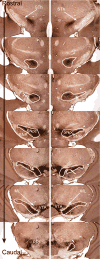A comparison of model-based (2D) and design-based (3D) stereological methods for estimating cell number in the substantia nigra pars compacta (SNpc) of the C57BL/6J mouse
- PMID: 19376196
- PMCID: PMC2705113
- DOI: 10.1016/j.neuroscience.2009.04.031
A comparison of model-based (2D) and design-based (3D) stereological methods for estimating cell number in the substantia nigra pars compacta (SNpc) of the C57BL/6J mouse
Abstract
The substantia nigra pars compacta (SNpc) is a compact brain structure that contains a variable distribution of cells in both medial to lateral and rostral to caudal dimensions. The SNpc is the primary brain structure affected in Parkinson's disease, where loss of dopaminergic neurons is one of the major hallmarks of the disorder. Neurotoxic and genetic models of Parkinson's disease, as well as mechanisms to treat this disorder, are modeled in the mouse. To accurately assess the validity of a model, one needs to be assured that the method(s) of analysis is accurate. Here, we determined the total number of dopaminergic neurons in the SNpc of the C57BL/6J mouse by serial reconstruction then compared that value to estimates derived using model-based stereology and design-based stereology. Serial reconstruction of the SNpc revealed the total number of SNpc dopaminergic neurons to be 8305+/-540 (+/-SEM). We compared this empirically derived neuron number to model based and design-based stereological estimates. We found that model based estimates gave a value of 8002+/-91 (+/-SEM) while design-based estimates were 8716+/-338 (+/-SEM). Statistical analysis showed no significant difference between estimates generated using model- or design-based stereological methods compared to empirically-derived counts using serial reconstruction.
Figures




Similar articles
-
Dietary administration of paraquat for 13 weeks does not result in a loss of dopaminergic neurons in the substantia nigra of C57BL/6J mice.Regul Toxicol Pharmacol. 2014 Mar;68(2):250-8. doi: 10.1016/j.yrtph.2013.12.010. Epub 2014 Jan 3. Regul Toxicol Pharmacol. 2014. PMID: 24389362
-
Pharmacokinetic, neurochemical, stereological and neuropathological studies on the potential effects of paraquat in the substantia nigra pars compacta and striatum of male C57BL/6J mice.Neurotoxicology. 2013 Jul;37:1-14. doi: 10.1016/j.neuro.2013.03.005. Epub 2013 Mar 21. Neurotoxicology. 2013. PMID: 23523781
-
Assessment of the Effects of MPTP and Paraquat on Dopaminergic Neurons and Microglia in the Substantia Nigra Pars Compacta of C57BL/6 Mice.PLoS One. 2016 Oct 27;11(10):e0164094. doi: 10.1371/journal.pone.0164094. eCollection 2016. PLoS One. 2016. PMID: 27788145 Free PMC article.
-
Age and Parkinson's disease-related neuronal death in the substantia nigra pars compacta.J Neural Transm Suppl. 2009;(73):203-13. doi: 10.1007/978-3-211-92660-4_16. J Neural Transm Suppl. 2009. PMID: 20411779 Review.
-
MPTP and SNpc DA neuronal vulnerability: role of dopamine, superoxide and nitric oxide in neurotoxicity. Minireview.Neurotox Res. 2005;7(3):193-202. doi: 10.1007/BF03036449. Neurotox Res. 2005. PMID: 15897154 Review.
Cited by
-
Database of literature derived cellular measurements from the murine basal ganglia.Sci Data. 2020 Jul 6;7(1):211. doi: 10.1038/s41597-020-0550-3. Sci Data. 2020. PMID: 32632099 Free PMC article.
-
Loss of GABAergic cortical neurons underlies the neuropathology of Lafora disease.Mol Brain. 2014 Jan 28;7:7. doi: 10.1186/1756-6606-7-7. Mol Brain. 2014. PMID: 24472629 Free PMC article.
-
Neurodegeneration by activation of the microglial complement-phagosome pathway.J Neurosci. 2014 Jun 18;34(25):8546-56. doi: 10.1523/JNEUROSCI.5002-13.2014. J Neurosci. 2014. PMID: 24948809 Free PMC article.
-
The impact of dextran sodium sulphate and probiotic pre-treatment in a murine model of Parkinson's disease.J Neuroinflammation. 2021 Jan 9;18(1):20. doi: 10.1186/s12974-020-02062-2. J Neuroinflammation. 2021. PMID: 33422110 Free PMC article.
-
Single-cell analysis of gene expression in the substantia nigra pars compacta of a pesticide-induced mouse model of Parkinson's disease.Transl Neurosci. 2022 Sep 1;13(1):255-269. doi: 10.1515/tnsci-2022-0237. eCollection 2022 Jan 1. Transl Neurosci. 2022. PMID: 36117858 Free PMC article.
References
-
- Abercrombie M. Estimation of nuclear population from microtome sections. Anat Rec. 1946;94:239–247. - PubMed
-
- Benes FM, Lange N. Two-dimensional versus three-dimensional cell counting: a practical perspective. Trends Neurosci. 2001;24:11–17. - PubMed
-
- Betarbet R, Sherer TB, MacKenzie G, Garcia-Osuna M, Panov AV, Greenamyre JT. Chronic systemic pesticide exposure reproduces features of Parkinson’s disease. Nat Neurosci. 2000;3:1301–1306. - PubMed
-
- Bezard E, Dovero S, Belin D, Duconger S, Jackson-Lewis V, Przedborski S, Piazza PV, Gross CE, Jaber M. Enriched environment confers resistance to 1-methyl-4-phenyl-1,2,3,6-tetrahydropyridine and cocaine: involvement of dopamine transporter and trophic factors. J Neurosci. 2003;23:10999–11007. - PMC - PubMed
Publication types
MeSH terms
Substances
Grants and funding
LinkOut - more resources
Full Text Sources
Miscellaneous

